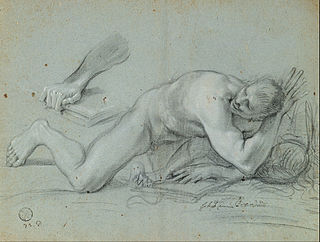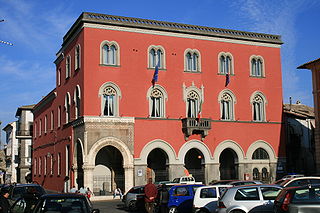
Veii was an important ancient Etruscan city situated on the southern limits of Etruria and 16 km (9.9 mi) north-northwest of Rome, Italy. It now lies in Isola Farnese, in the comune of Rome. Many other sites associated with and in the city-state of Veii are in Formello, immediately to the north. Formello is named after the drainage channels that were first created by the Veians.

Orvieto is a city and comune in the Province of Terni, southwestern Umbria, Italy, situated on the flat summit of a large butte of volcanic tuff. The city rises dramatically above the almost-vertical faces of tuff cliffs that are completed by defensive walls built of the same stone.

Cortona is a town and comune in the province of Arezzo, in Tuscany, Italy. It is the main cultural and artistic centre of the Val di Chiana after Arezzo.

Trevignano Romano is a small town and comune in the Metropolitan City of Rome, Lazio, central Italy. With a population of about 5,000, it is located on the volcanic Lake Bracciano. It is about 47 kilometres (29 mi) away from Rome.

Grammichele is a town and comune in the Metropolitan City of Catania in Sicily, southern Italy. It is located at the feet of the Hyblaean Mountains, some 13 kilometres (8 mi) from Caltagirone.

Cetona is a town and comune in the southern part province of Siena, Tuscany, in an area where Umbria and Lazio meet. It is one of I Borghi più belli d'Italia.

Artena is a town and comune in the Metropolitan City of Rome, Italy. It is situated in the northwest of Monti Lepini, in the upper valley of the Sacco River. It is approximately 40 kilometres (25 mi) southeast by rail, and 30 kilometres (19 mi) direct from Rome.

Fermo is a town and comune of the Marche, Italy, in the Province of Fermo.

Giovanni Angelo Canini (1609–1666) was an Italian painter and engraver of the Baroque period.
Monteroni di Lecce (Salentino: Muntrùni is a town and comune in the province of Lecce, in Apulia, southern Italy. In 2008, it had 13,800 inhabitants. It is 7 kilometres from Lecce, in the Salento – the historic Terra d'Otranto.

Montescaglioso is a town and comune in the Province of Matera, Basilicata, southern Italy.

Soriano nel Cimino is a town and comune in the province of Viterbo, Lazio, central Italy.

Castellina in Chianti is a comune (municipality) of c. 2,800 inhabitants in the province of Siena, in the Italian region Tuscany, located about 35 kilometres (22 mi) south of Florence and about 15 kilometres (9 mi) northwest of Siena. It is part of the Chianti Hills, between the valleys of the Arbia, Pesa and Elsa rivers.

Barbarano Romano is a comune (municipality) in the Province of Viterbo in the Italian region of Latium, located about 50 kilometres (31 mi) northwest of Rome and about 20 kilometres (12 mi) south of Viterbo.

Campagnano di Roma is a comune (municipality) in the Metropolitan City of Rome in the Italian region of Latium, located about 30 kilometres northwest of Rome. It was first mentioned in 1076, having been carved out of the great estate assembled on the Roman pattern by Pope Adrian I, ca. 780, his Domusculta Capracorum. In medieval times, Campagnano di Roma was on the via Francigena. Here, Sigeric, Archbishop of Canterbury, sojourned on his return journey from Rome about 990.

Sacrofano is a comune (municipality) in the Metropolitan City of Rome in the Italian region of Latium, located about 25 kilometres (16 mi) north of Rome. Located near the Monti Sabatini, at the feet of an extinct volcano, it is included in the Regional Park of Veii.

Sambuca di Sicilia is a comune (municipality) in the Province of Agrigento in the Italian region Sicily, located about 68 kilometres (42 mi) southwest of Palermo and about 89 kilometres (55 mi) northwest of Agrigento. It is one of I Borghi più belli d'Italia.

Sovana is a small town in southern Tuscany, Italy, a frazione of Sorano, a comune in the province of Grosseto. It is one of I Borghi più belli d'Italia.

Cesano is the 52nd zona of Rome, Italy, identified by the initials Z. LII. It takes its name from the small medieval village of Cesano di Roma, on the Via Cassia, which is located within the Municipio XV, 27 km from Rome proper.
San Lorenzo in Quintiliano is a small Romanesque-style, Roman Catholic church, located on a hilltop just outside the town of Contigliano, in the province of Rieti, region of Lazio, Italy. The church has no roof, and remains a deconsecrated ruin.





























